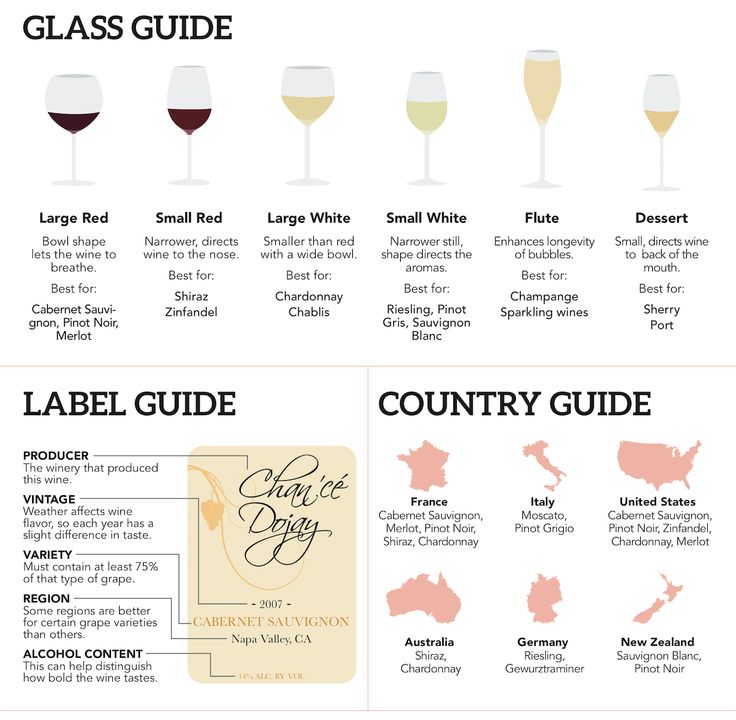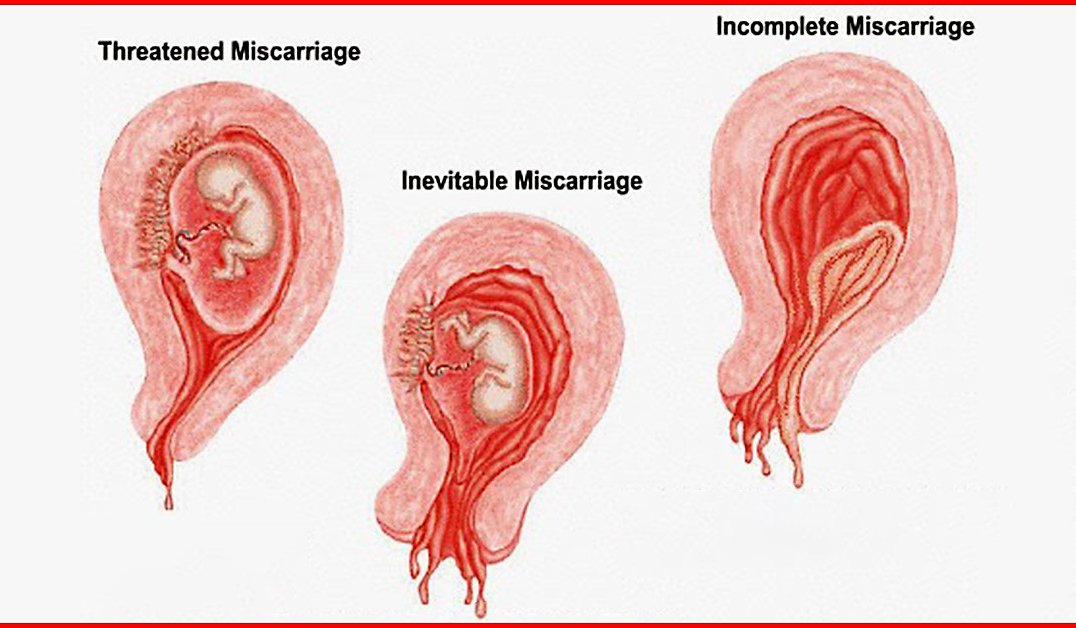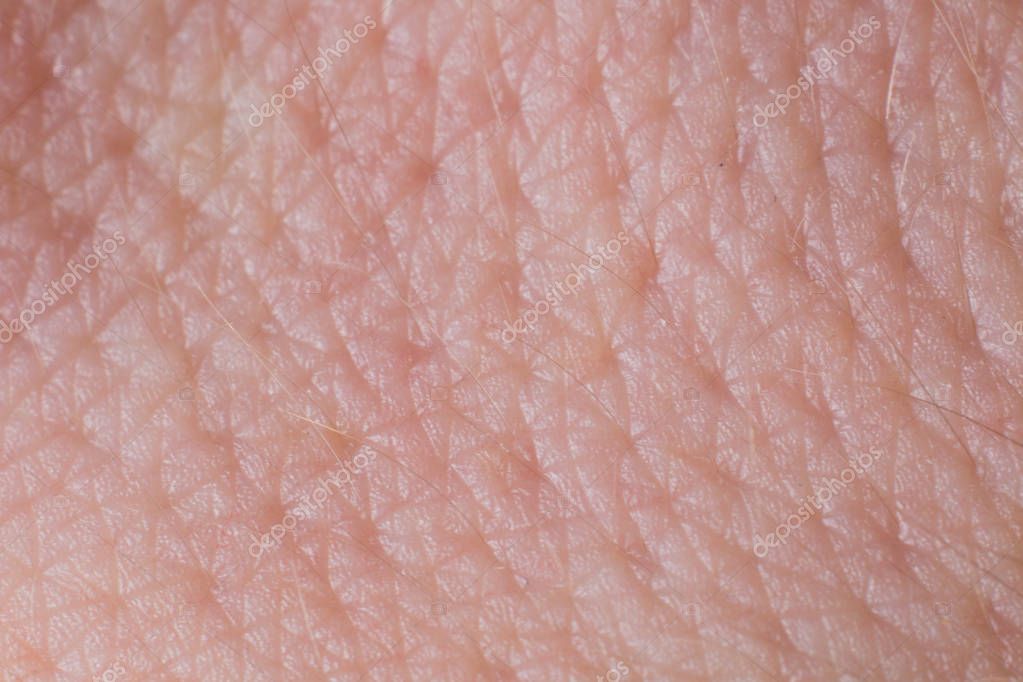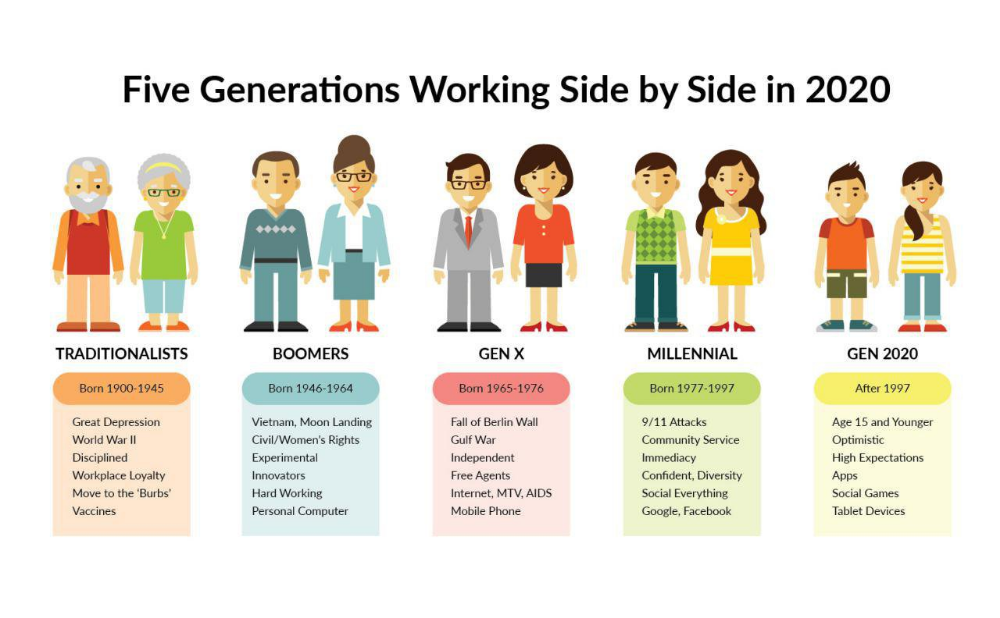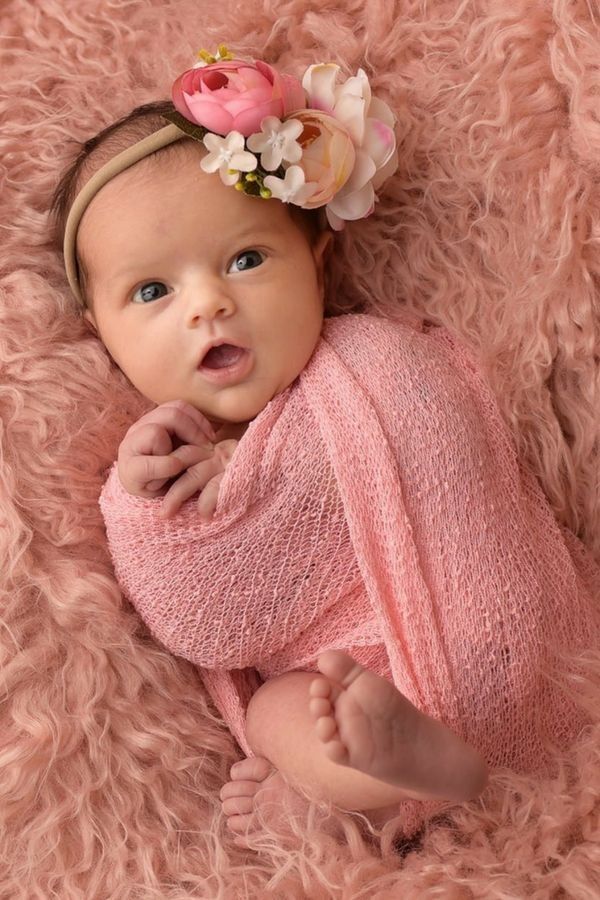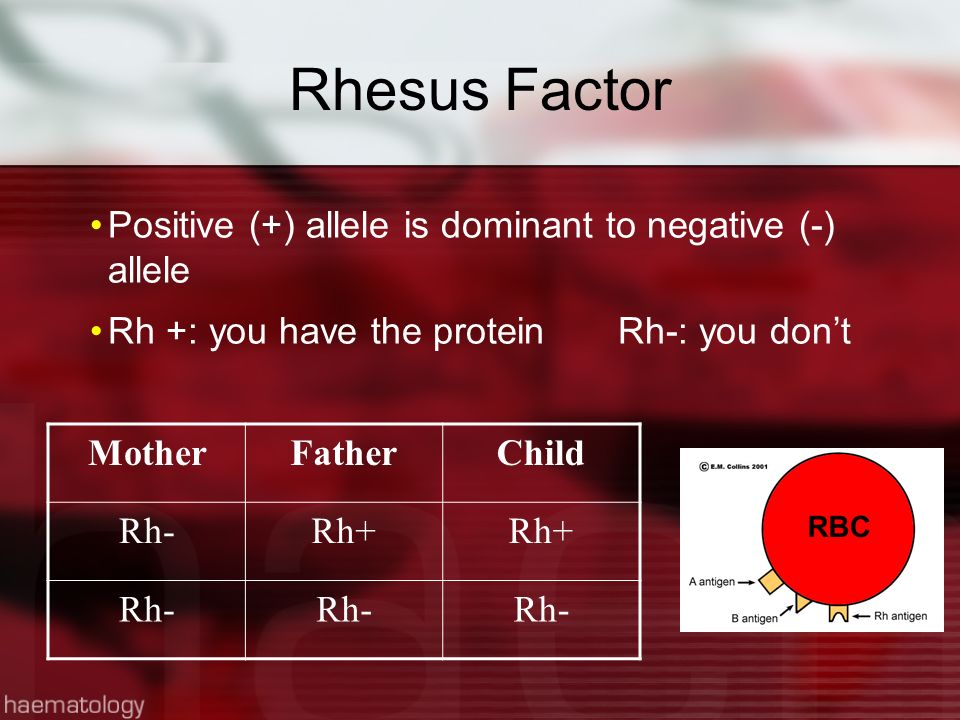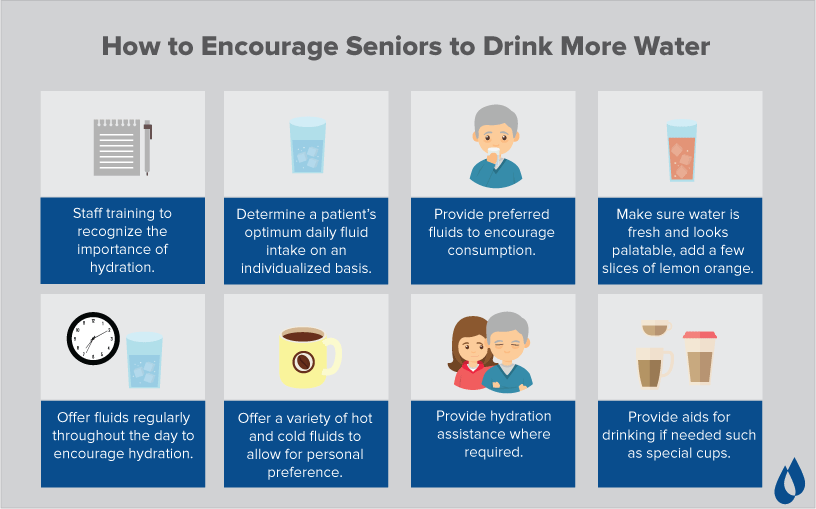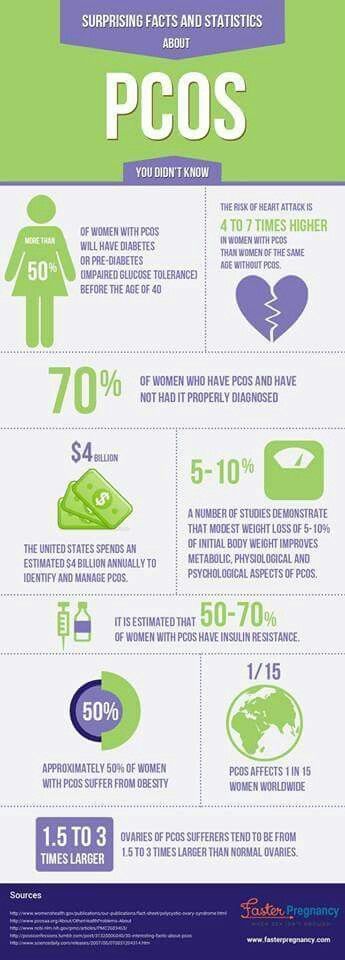Sterilize baby bottles in the microwave
How to Sterilize Baby Bottles
Once you’ve done your research and decided on the best bottles for baby, there’s still another step to consider: how to clean them. Whether you’ve chosen glass, plastic or silicone bottles, you’ll have to keep them as pristine as possible to protect baby’s developing immune system. If you listen to advice from your mother or grandmother, you might be fretting over how to sterilize baby bottles—but nowadays sterilizing baby bottles isn’t absolutely necessary, except in certain situations. “This practice is a bit outdated now that the majority of homes in developed countries use treated municipal water,” says Caitlin Hoff, a health and safety investigator for ConsumerSafety.org. “There are, however, some cases in which you might want to sterilize a bottle.” Here, we break down when sterilizing baby bottles is a good idea and the best methods for the job.
In this article:
When to sterilize baby bottles
How often to sterilize baby bottles
How to sterilize baby bottles
How to clean baby bottles
When to Sterilize Baby Bottles
Sterilizing baby bottles is an added step beyond traditional cleaning that provides extra protection against germs. And generally speaking, it’s a one-and-done deal. “When you first buy bottles, it’s important to sterilize them at least one time,” says Samira Armin, MD, a pediatrician at Texas Children’s Pediatrics. After all, you don’t know where that bottle was before it was packaged and sold to you, so an initial sterilization is a quick, easy way to ensure baby’s health and safety. “After that, it’s no longer necessary to sterilize bottles or their accessories,” she adds. “Many years ago, when water supplies weren’t reliably clean, baby items required sterilization, but nowadays this is thankfully not an issue.”
That said, there are instances when you might want to sterilize baby’s bottle beyond that first use. According to Hoff, these include:
• If you’re using borrowed or second-hand bottles. With all the gear and supplies that babies require, some moms hit up consignment shops or borrow baby bottles from a friend. In these cases, it’s critical to sterilize pre-used bottles before giving it to your child for the first time.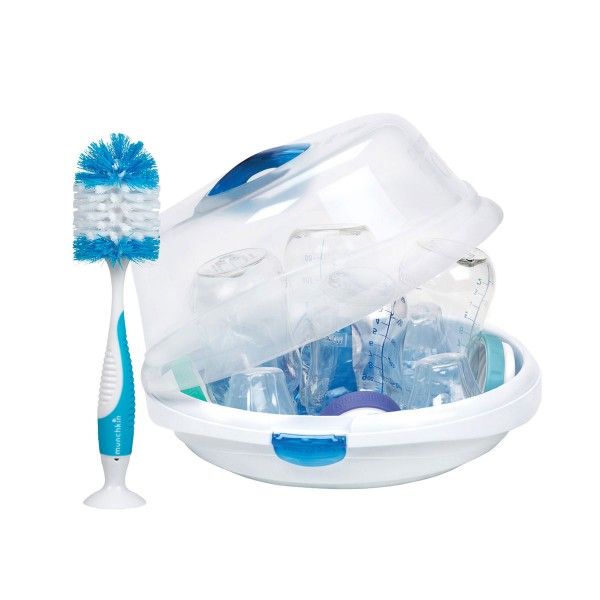 The same goes for bottles that have been used for older siblings in your own home.
The same goes for bottles that have been used for older siblings in your own home.
• If baby has been sick. It’s no fun when baby’s sick, so the last thing you want to do is risk re-infecting them by using unclean bottles. “If you’re concerned about any lingering germs or bacteria on your child’s bottles, sterilizing them will certainly put your mind at ease,” Hoff says.
• If baby was premature or has health issues. According to the Centers for Disease Control and Prevention (CDC), sterilization is particularly important if baby was born prematurely or has a weakened immune system.
• If you don’t have access to clean drinking water. If your home isn’t part of a municipality with clean drinking water, you use well water or you’re traveling in a country with questionable water, you may need to sterilize baby’s bottles often; once daily or even after each use would be prudent to avoid buildup of harmful microbes.
How Often to Sterilize Baby Bottles
As long as you have good quality municipal drinking water that isn’t coming from a well, it’s not necessary (or even recommended) to sterilize baby’s bottles too often. “Regular sterilization can potentially damage the bottle and allow chemicals to leach into the milk, especially if the bottle has BPA in it,” says Daniel Ganjian, MD, a pediatrician at St. John’s Health Center in Santa Monica, California. The Food and Drug Administration (FDA) banned the use of bisphenol A, or BPA, in baby bottles back in 2012 due to concerns over the chemical’s impact on infant development—but if you’re using older plastic bottles, make sure they don’t have the recycling number 7 imprinted on the bottom.
“Regular sterilization can potentially damage the bottle and allow chemicals to leach into the milk, especially if the bottle has BPA in it,” says Daniel Ganjian, MD, a pediatrician at St. John’s Health Center in Santa Monica, California. The Food and Drug Administration (FDA) banned the use of bisphenol A, or BPA, in baby bottles back in 2012 due to concerns over the chemical’s impact on infant development—but if you’re using older plastic bottles, make sure they don’t have the recycling number 7 imprinted on the bottom.
How often to sterilize baby bottles is really up to you, so do what feels right for your family. If you use a dishwasher with hot water and a heated drying cycle to clean your child’s feeding items, sanitizing baby bottles by hand isn’t called for. Otherwise, for extra germ removal beyond standard washing, the CDC says you can sanitize bottles at least once daily.
When to stop sterilizing baby bottles
If you do decide to sterilize baby’s bottles regularly, it’s okay to stop once baby is older than 3 months, according to CDC guidelines, since baby’s immune system isn’t quite so fragile anymore.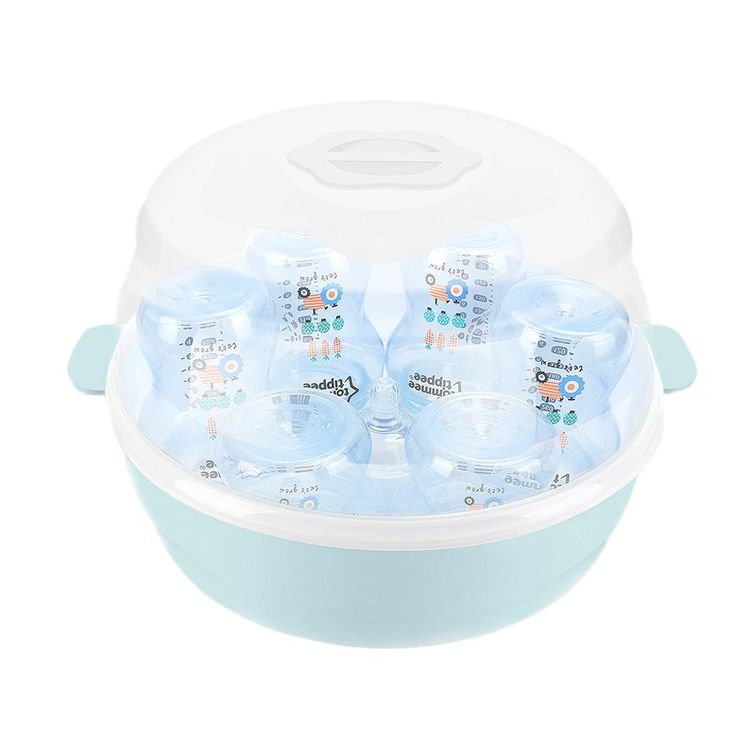
You should also stop sterilizing baby bottles and accessories if you notice any damage, Ganjian says. Glass bottles with cracks or chips should be tossed out, as should plastic bottles with splits, cracks, strong odors or any warping. Bottle nipples that have sustained noticeable wear and tear should always be replaced, since they can be a choking hazard.
How to Sterilize Baby Bottles
Sterilization kills bacteria in bottles through the use of high temperatures or chemicals, Armin says, and one method isn’t superior to another. So when it comes to deciding how to sterilize baby bottles, choose an approach that works best for you and your budget. Read on for step-by-step instructions for how to sterilize baby bottles using various techniques.
Sterilizing baby bottles with boiling water
No special equipment required here! To sterilize baby bottles using boiling water, all you need is water and a pot. And don’t worry—it’s fine to sanitize plastic bottles using this method.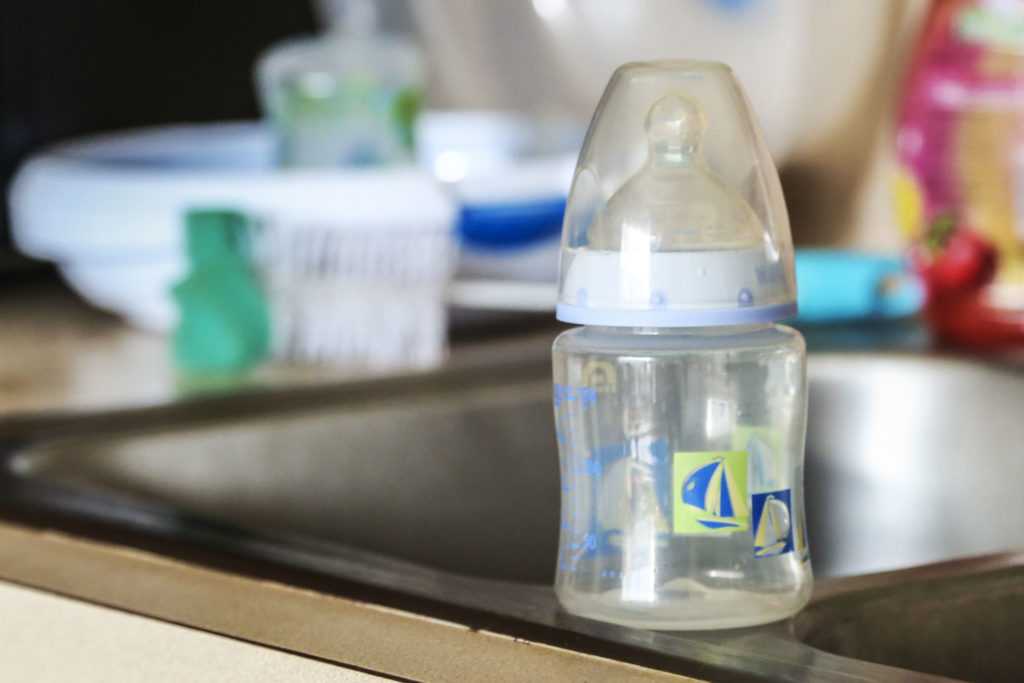
- Fill a large, clean pot with enough water to cover the bottles.
- Submerge the freshly washed bottles in the water upside down, making sure there aren’t any air bubbles at the bottom.
- Bring the water to a boil.
- Boil the bottles for five minutes (check manufacturer guidelines for variations).
- Turn the heat off and remove the bottles using tongs.
- Place them on a clean, dry dishcloth and allow them to air dry.
Sterilizing baby bottles in the microwave
Another super-easy approach to sterilizing baby bottles? Using your microwave’s steam power! Here’s how to sterilize baby bottles in the microwave without any other special equipment:
- Start with a clean microwave.
- Fill bottles about halfway with water.
- Microwave on high for one to two minutes.
- Using oven mitts, remove bottles from the microwave, dump remaining water out and let the bottles air dry.
Another option is to purchase a microwave baby bottle sterilizer.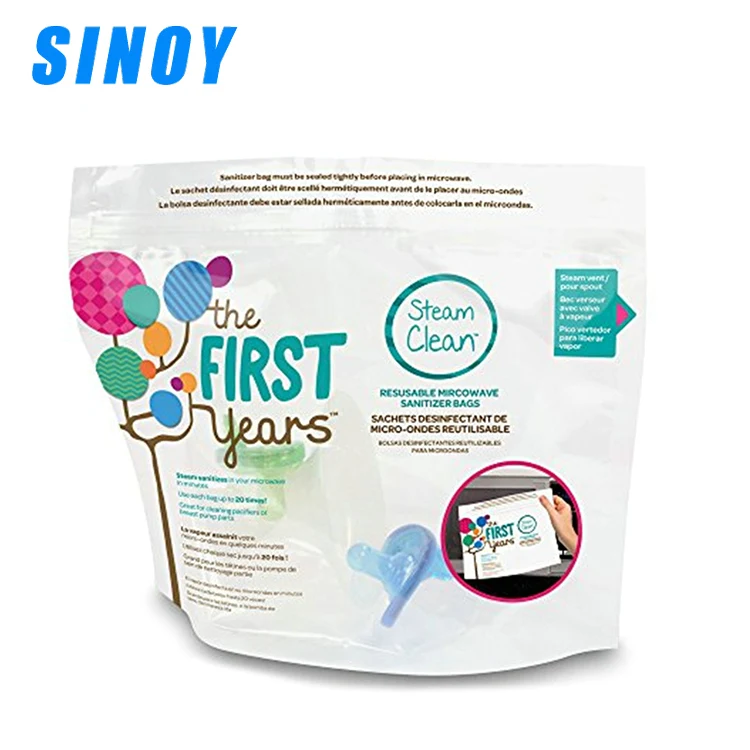 This type of sterilizer also harnesses the power of steam, but it encloses the bottles in a plastic casing to give them a more thorough cleansing. These handy sterilizers are widely available and typically cost about half as much as the better-known electric baby bottle sterilizers.
This type of sterilizer also harnesses the power of steam, but it encloses the bottles in a plastic casing to give them a more thorough cleansing. These handy sterilizers are widely available and typically cost about half as much as the better-known electric baby bottle sterilizers.
Sterilizing baby bottles with electric steam
If you know you’ll sleep easier if baby’s bottles are sterilized regularly, you may want to spring for a countertop bottle sterilizer. Steam sterilization can reach higher temperatures than boiling water, so it can kill more bacteria and mold, Ganjian says.
Though they’re a bit more pricey than any of the other options, electric baby bottle sterilizers are probably the quickest, easiest option if you want (or need) to sanitize bottles frequently. Simply follow the instructions provided by the manufacturer. Plus, they can be used to sanitize bottles, bottle parts, nipples and more. Many moms even use these for small plastic toys and teething rings once baby outgrows the bottle stage.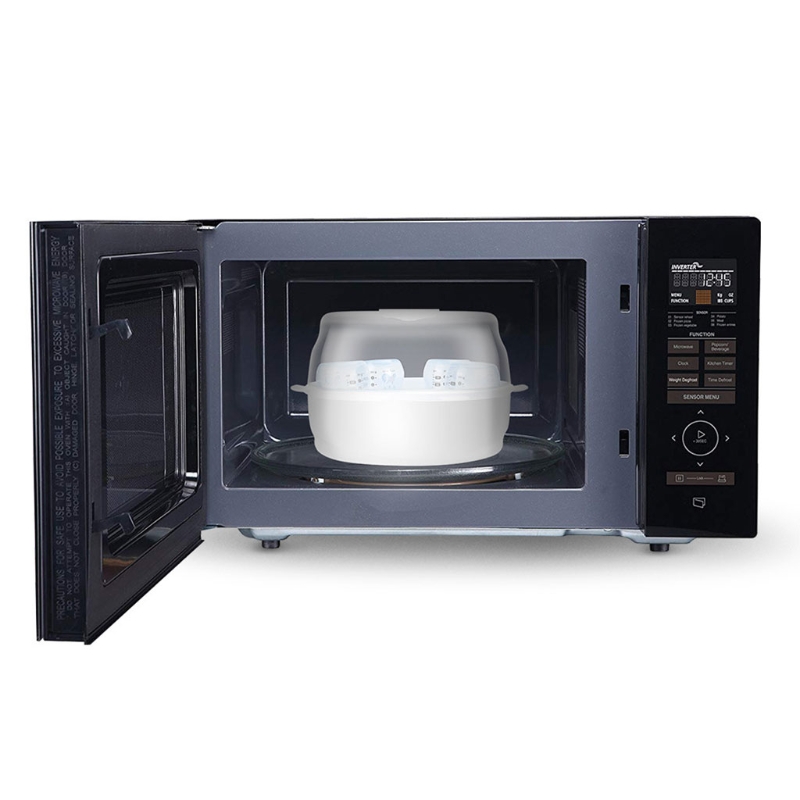 That’s knowing how to stretch a dollar!
That’s knowing how to stretch a dollar!
Sterilizing baby bottles with bleach
If you’re in a pinch and don’t have access to boiling water, steam or a dishwasher, the CDC condones the use of bleach to clean baby bottles. Here’s how to sterilize baby bottles with this method:
- Combine one teaspoon of unscented bleach with 16 cups of hot water.
- Submerge bottles in the solution, taking care to avoid any air bubbles in the bottom of the bottles.
- Soak bottles for two to five minutes, then remove with clean tongs.
- Place bottles on a clean dish towel to air dry. There’s no need to rinse, Armin says: “Any remaining bleach will break down quickly during the air-drying process and will not harm baby.”
Sterilizing baby bottles using sterilizing tablets
Wondering how to sterilize baby bottles when you’re away from home and don’t have access to your normal equipment? Food-grade, chlorine-based sterilizing tablets are just as effective at removing all the same microbes as the other sterilization techniques above.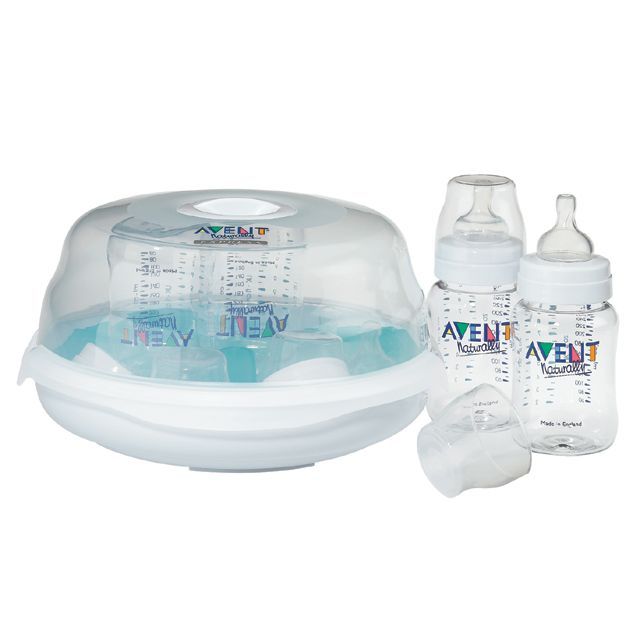 Be sure to follow the instructions on the packaging to ensure proper sterilization.
Be sure to follow the instructions on the packaging to ensure proper sterilization.
How to Clean Baby Bottles
Regardless of whether you decide to sterilize baby’s bottles, you’ll still have to thoroughly clean them after every feeding. “Newborns and infants have underdeveloped immune systems are vulnerable to infections by viruses, bacteria, parasites and fungi, which can all lead to illness. These germs can grow quickly if breast milk or formula is added to a partially used bottle that hasn’t been well cleaned,” Armin says. “Washing items thoroughly with hot water and soap is all that’s required to remove most harmful germs from bottles.” You can choose to wash bottles and their parts by hand or in the dishwasher. Here’s how:
Cleaning baby bottles in the dishwasher
Are your baby bottles dishwasher safe? Good news: Using your dishwasher’s hottest water setting and a heated drying cycle effectively sterilizes the bottles!
- Separate all bottle parts.

- Rinse the bottles and parts with clean water to remove any milk particles.
- Place all small parts (including rings, valves and nipples) in a dishwasher-safe basket to prevent them from falling to the bottom of the dishwasher.
- When possible, run the bottles on a hot-water cycle and heated drying cycle or select the sanitizing setting.
- Remove the bottles and parts from the dishwasher and allow to air dry on a clean dishcloth.
Cleaning baby bottles by hand
When cleaning by hand, the CDC recommends washing the bottles and their parts in a special container that’s only used for bottles, rather than having bottles come in contact with the sink, to prevent cross-contamination. You should also use a bottle brush or other cleaning utensil that’s set aside just for baby’s bottles.
- Start with clean hands.
- Separate the bottles and their parts and rinse each piece under running hot or cold water to remove any milk particles.
 Don’t set the bottles down in the sink.
Don’t set the bottles down in the sink. - Fill a clean basin with hot water and soap.
- Scrub the bottles and parts with a bottle brush, taking care to thoroughly clean all the way to the bottom of the bottle.
- Clean inside the nipples, making sure to flush water through the tiny holes at the tips.
- Rinse again under running water.
- Air dry on a clean dishcloth.
Updated February 2020
Expert bios:
As a health and safety investigator for ConsumerSafety.org, Caitlin Hoff educates families about important consumer topics that impact the general public’s health and safety. She holds a certification in CDC Health Literacy for Public Health Professionals.
Samira Armin, MD, FAAP, is a pediatrician at Texas Children’s Pediatrics. She earned her medical degree from St. George’s University in 2009 and specializes in newborns and healthy eating.
Daniel Ganjian, MD, is a pediatrician at Providence St.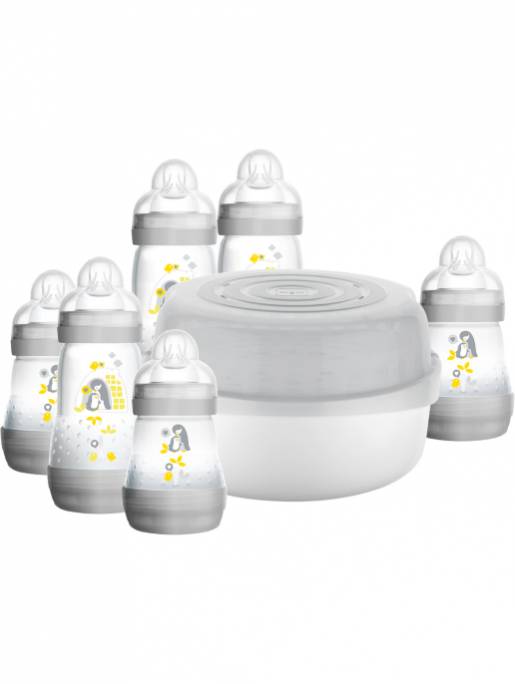 John’s Health Center in Santa Monica, California. He earned his medical degree from the University of California, Irvine, in 2004 and is a member of the Alpha Omega Alpha honor society, a designation given to just 10 percent of American physicians.
John’s Health Center in Santa Monica, California. He earned his medical degree from the University of California, Irvine, in 2004 and is a member of the Alpha Omega Alpha honor society, a designation given to just 10 percent of American physicians.
Please note: The Bump and the materials and information it contains are not intended to, and do not constitute, medical or other health advice or diagnosis and should not be used as such. You should always consult with a qualified physician or health professional about your specific circumstances.
Plus, more from The Bump:
16 Best Baby Bottles
How Much Should a Newborn Eat?
Pumping Breast Milk 101
The top 4 ways to sterilize your baby's bottles – Minbie US
It goes without saying, your main priority is to keep your children safe and healthy.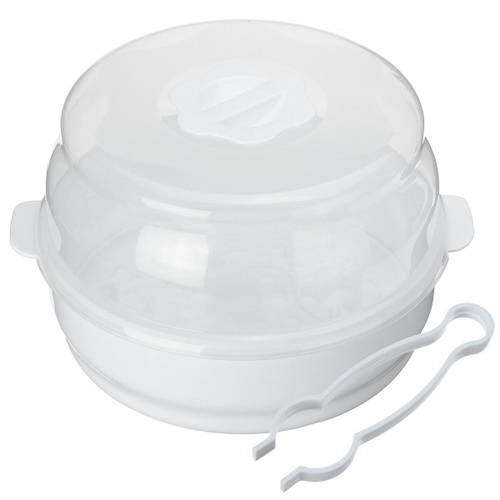 Sterilizing your baby's bottles and accessories is one key way you can protect your little ones from harmful bacteria and germs.
Sterilizing your baby's bottles and accessories is one key way you can protect your little ones from harmful bacteria and germs.
Naturally, we recommend Minbie's Sterilizer, but it's important to remember that however you choose to sterilize your baby's bottles & nipples, it's crucial you pick a way that won't degrade the material or damage it in any way.
BE PREPARED WITH THE VERY BEST STERILIZER TO KEEP YOUR FAMILY SAFE! CLICK HERE TO VIEW OUR STERILIZERS & BUNDLES!
When you invest in Minbie to help you feed and care for your children, you are choosing award winning design, great quality, and peace of mind for your journey.
Why is sterilisation important?
Sterilizing all bottles and nipples is incredibly important in order to keep your baby safe from harmful bacteria, viruses, parasites and other pathogens that can make them sick. When a baby is born they're especially vulnerable. Their newly formed immune systems aren’t yet strong enough to fight off certain infections, so making sure all bottles and feeding equipment are properly sterilized is one way to help ensure baby doesn't become ill. For instance, a 12-month-old still only has 15-17% of an adult level of the IgA immunoglobulin, which is important for fighting the bacteria that causes gastroenteritis.
For instance, a 12-month-old still only has 15-17% of an adult level of the IgA immunoglobulin, which is important for fighting the bacteria that causes gastroenteritis.
As your baby gets older, it can seem silly to be sterilizing bottles and nipples when everything else they get their hands on goes straight into their mouth! However, milk is particularly good at growing some of the nastiest pathogens so unsterilized bottles really do have the potential to make your baby much more sick than the pacifier on the sofa.
Cleaning, disinfecting and sterilizing are very different processes. Cleaning removes foreign particles like formula, milk and dirt whilst disinfecting destroys pathogenic (disease-causing) microorganisms and removes most organisms from the surface of an item.
Don't hesitate, just click "buy"⭐⭐⭐⭐⭐
'The Minbie Sterilizer & Dryer has saved me hours of time in a day washing bottles and breast pump parts.' Danique. J
J
Baby bottles should be sterilized every time they’re used, ideally directly before they are filled with formula, expressed breast milk or any other liquid. You can, however, sterilize them a little in advance if required; the exact length of time depends on the sterilization method.
Only sterilization eliminates all forms of life including ‘transmissible agents’ such as spores.
What do I really need to sterilize?
All of your baby’s feeding equipment should be sterilized. This includes bottles and all their components such as collars, nipples, lids, seals and any travel containers you use when you're out and about. If you express breast milk you also need to sterilize the components of your breast pump (follow the manufacturer's directions about which components need to be sterilized and for advice on how to carry out the process).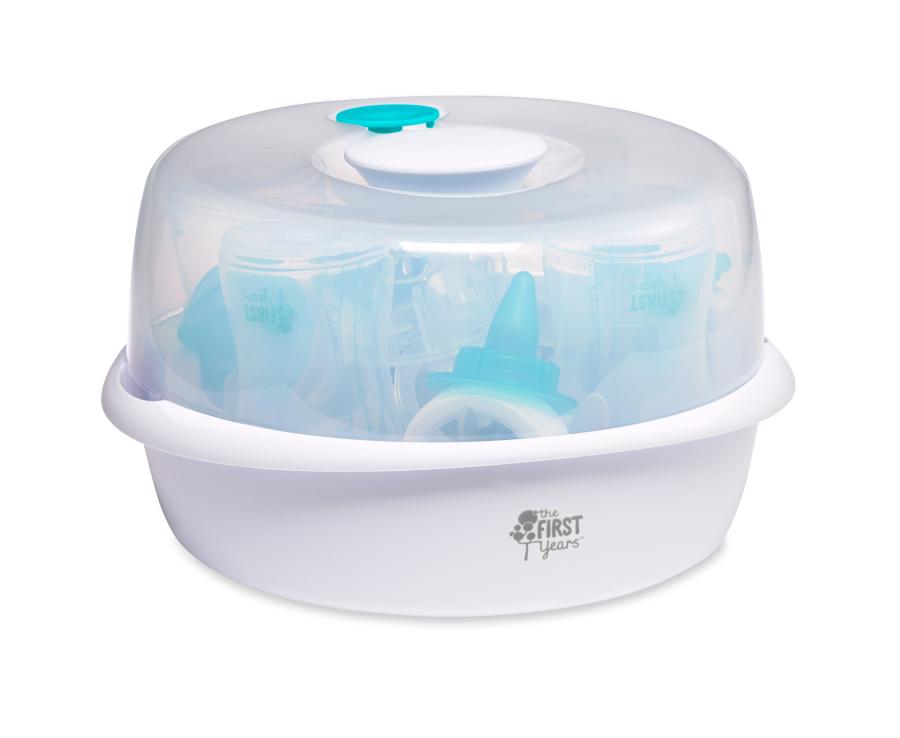 Pacifiers should be sterilized too.
Pacifiers should be sterilized too.
Sterilization Methods:
Boiling
Boiling is the most basic method of sterilizing using heat. To sterilize your baby bottles and nipples by boiling them, follow these steps:
- Check the manufacturers guidelines to make sure your bottles, nipples and anything else you wish to sterilize are able to be boiled safely.
- Put all the items you need to sterilize into a large pot.
- Fill the pot with water until everything is completely submerged. Make sure there aren’t any air bubbles inside any of the bottles or nipples.
- Bring the water to a rolling boil and boil for 10 minutes.
- Leave the sterilized items in the pot until you’re ready to fill them or store them in a sterilized container in the fridge. When removing your bottles and nipples, make sure the water has cooled enough that you won’t burn yourself.
- Repeat this process if you don’t use your bottles and nipples within 24 hours of boiling.
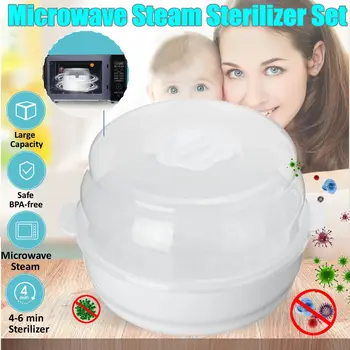
Pros
- This is the cheapest method of sterilization.
- You do not need any special equipment to use this sterilization method.
Cons
- Some nipples tend to degrade faster with this method of sterilization.
- This method is time consuming.
- You can't leave boiling water unattended whilst getting on with other things.
- There is a risk you may burn yourself or someone else using this method.
- You need lots of time & equipment for this method.
All Minbie products can be sterilized by boiling.
Steam sterilizer
The Minbie Steam Sterilizer & Dryer makes sterilising baby bottles and nipples very easy as it automates most of the process and uses natural steam to kill microorganisms.
To use the Minbie Steam Sterilizer & Dryer, simply put your clean baby bottles and nipples into the unit and add clean water according to the instructions. Then switch the unit on and leave it to do it's work. Our sterilizer will automatically turn off when done & keeps bottles sterile for up to 24 hours saving you time and space.
Then switch the unit on and leave it to do it's work. Our sterilizer will automatically turn off when done & keeps bottles sterile for up to 24 hours saving you time and space.
Pros
- This sterilization method is very simple to use.
- This method is more effective than boiling or microwave sterilizing as there is less room for human error.
- Sterilize many bottles at once saving time.
- This sterilization method doesn’t cause bottles and nipples to degrade as boiling does.
- Steam is 100% natural and this process uses no chemicals.
- Fast, easy sterilization.
- Storage functions make life easier for busy moms.
Cons
- Steam Sterilizers occasionally need descaling.
This sterilization method can be used on Minbie nipples and bottles.
MicrowaveMicrowave sterilization uses steam (heat) to sterilize baby bottles and nipples. You’ll get the best results if you purchase a sterilization unit that is designed to be used to sterilize baby bottles in a microwave.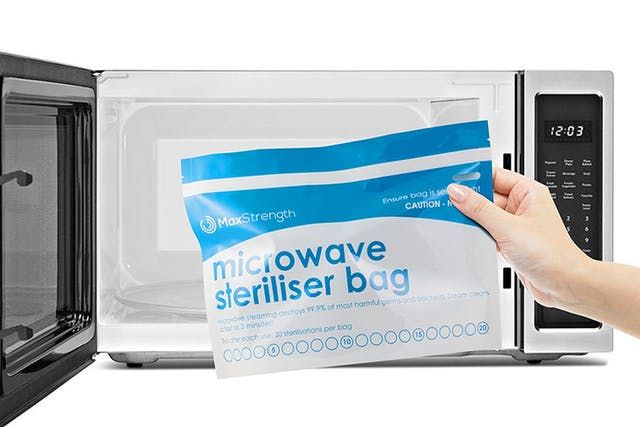
To use these sterilizers, follow the manufacturer’s instructions carefully. Be especially careful that you use the correct power setting on your microwave. If you don’t, you may melt your baby bottles and nipples. You should also ensure you position all bottles and nipples with the openings facing downwards in the sterilizer. If you’re not using the sterilized items immediately, you can store them in the sterilizing unit provided you leave it sealed but consult the manufacturer’s instructions to determine how long you can do this for.
Never put your baby feeding equipment directly into the microwave to sterilize it; it won't effectively sterilize the bottles or nipples and will likely damage them. You should also ensure you never microwave metal items inside a microwave sterilizer.
Pros
- Sterilization is accomplished quickly and easily using this method.
- Microwave steamers are usually fairly inexpensive.
Cons
- Not all baby feeding equipment can be microwaved.
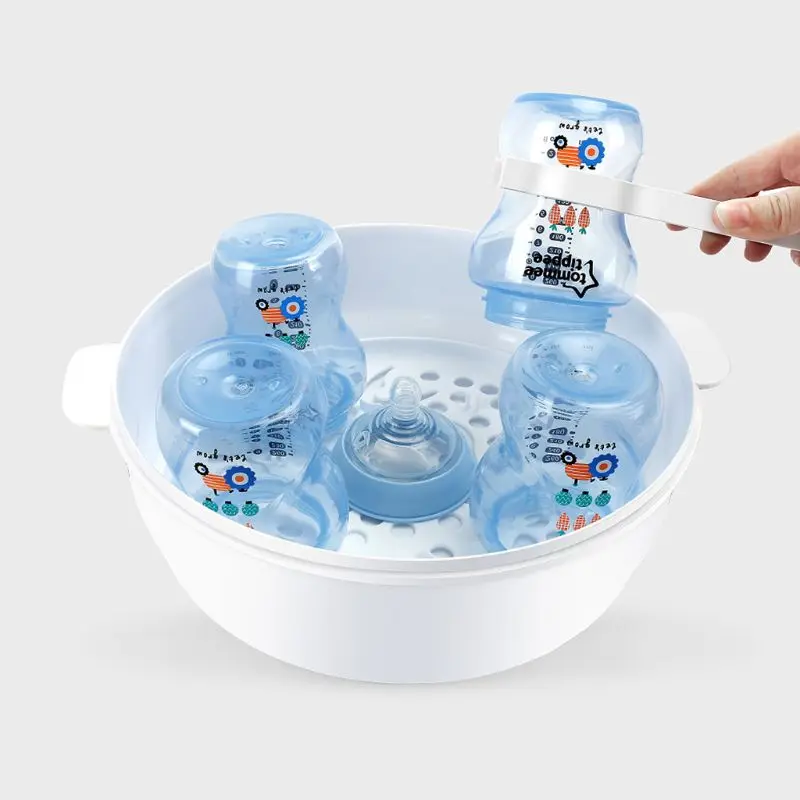
- If you have lots of items to sterilise, it's safer to do them in small batches, which is time consuming.
- Failing to add enough water to the unit may cause the sterilizer to melt or even catch fire.
- You need to be careful to avoid being burned when using this method.
- You may not always have access to a microwave, so you'll need a back up plan.
- Failure to take bottles apart before sterilization causes a pressure build up which could be incredibly dangerous.
- Microwave sterilizers can be bulky and messy to use.
This sterilisation method can be used on Minbie nipples and bottles
Cold-sterilisation chemicalsCold-sterilization chemicals work by disinfecting bottle feeding equipment. There are a range of sterilizing chemicals available. You can get ready-made liquids, dissolvable powders and effervescent tablets. The active agent varies but many products rely on sodium hypochlorite or sodium dichloroisocyanurate for their disinfectant properties.
In order for these chemicals to disinfect and sterilize properly you must follow the instructions carefully.
To sterilize using one of these products, follow these steps:
- Make up the sterilization solution according to the manufacturer’s instructions in a dedicated sterilization container.
- Put the items you wish to sterilize in your chosen container, making sure they’re covered by the sterilization solution and that there aren’t any bubbles trapped anywhere inside your bottles or nipples.
- Leave your bottles and nipples in the solution for at least the recommended time (usually about 30 mins but be sure to check the manufacturer’s instructions). Whatever container you choose to use for this process, make sure you have a plunger or floating cover that you can use to keep your bottles and nipples completely submerged under the liquid for the entire time.
- Leave your sterilized items in the solution until you need to use them, provided you don’t leave them in there for longer than 24 hours.
 After 24 hours, you need to replace the sterilization solution.
After 24 hours, you need to replace the sterilization solution.
You should wash the container you use to sterilize with warm soapy water before filling it with each batch of fresh sterilization solution. Don’t store cold-sterilization liquid in a metal container as the chemicals will slowly eat away at the metal.
Pros
- Once you’ve made up a sterilization solution, you can add and remove items throughout the day for as long as the solution remains effective (this is usually 24 hours but refer to the manufacturer’s instructions for the specific product you’re using).
- This method of sterilization can be used when you’re out and about and don’t have access to the equipment needed for other sterilization methods.
- This method of sterilization shouldn’t cause your bottles and nipples to degrade more quickly provided you only leave them in the solution for the minimum amount of time required for successful sterilization.
Cons
- Not all baby bottles are compatible with the chemicals in these products.
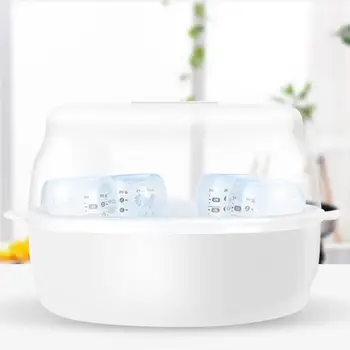
- Your baby may be sensitive to one or more of the ingredients in these products.
- These products have a use-by date.
- It can be more difficult to use this sterilization method properly (for instance these products only work if the chemicals are used in the right concentration so if you’re not using a pre-mixed solution you need to be able to accurately measure the water you use to prepare them).
- Leaving your baby bottles and nipples in cold-sterilization chemicals for extended periods of time may cause them to degrade more rapidly than other sterilisation methods.
- This method is time consuming and can be messy.
This sterilization method can be used on Minbie nipples and bottles (and associated parts).
Things to remember
Sterilizing baby bottles and nipples is only effective if every component of the bottle as well as everything that comes into contact with the bottle (your hands and any bottle lids or seals that might be used to mix formula) are clean. So, be sure to sterilize any utensils you use to make up formula and always wash your hands thoroughly before you touch sterilized bottles and nipples.
So, be sure to sterilize any utensils you use to make up formula and always wash your hands thoroughly before you touch sterilized bottles and nipples.
You’ll find it easier to clean baby feeding equipment if you use hot, soapy water immediately after a feed and then rinse to remove soapy residue. For bottles and nipples that are dishwasher safe, make sure you only wash them in the top rack of the dishwasher.
Always dispose of any bottles or nipples that are cracked, chipped, torn or damaged in any way. This will help to prevent injuries and eliminate sneaky places that pathogens can hide.
Important
Never put your Minbie baby bottles or nipples in the oven.If you have bottles or nipples that contain BPA, it’s best to avoid sterilizing with heat, especially using the boiling method (which exposes them to heat for the longest amount of time), as this may cause the potentially harmful BPA to leach more rapidly. All Minbie products are BPA-free.
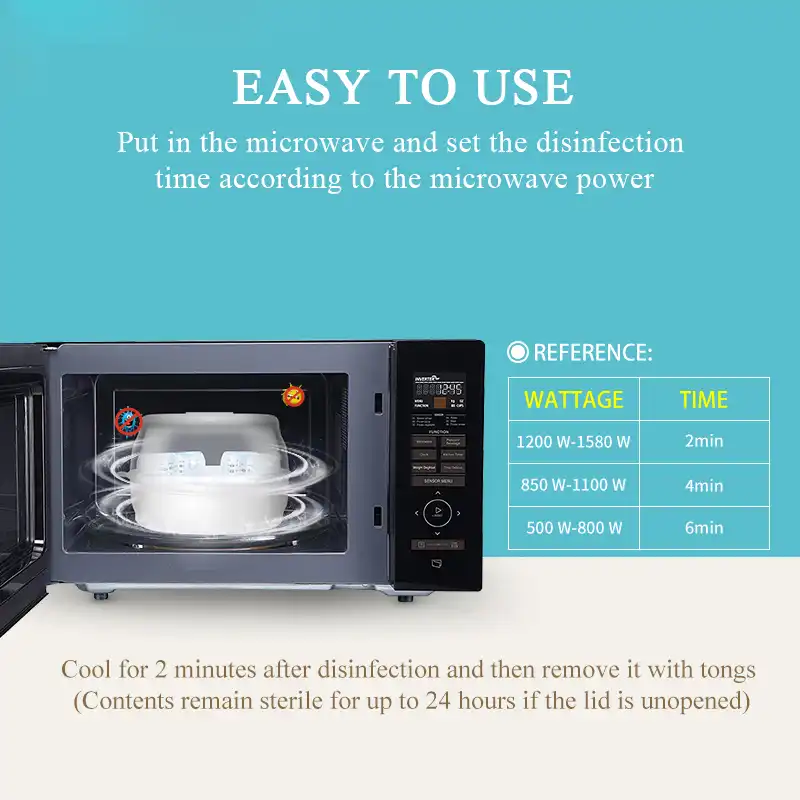
Make sure you have the very best steriliser to keep your family safe! Click here to view our Sterilisers & Bundles!
How to Sterilize Bottles in the Microwave: 3 Ways, Tips
Breastfeeding should be preceded by sterilization of bottles, which will destroy possible bacteria that can cause disease, which the infant's immune system is not yet able to fight. Sterilization, like washing, is a must every time you breastfeed your baby.
The process can be facilitated by using a microwave oven if the bottles are suitable for heating in it. How to sterilize bottles in the microwave is described below. The procedure will not destroy the integrity of the bottles, and will not introduce foreign substances into the milk for the baby. nine0003
You can use:
- special sterilizer,
- special bags,
- just pan.
For processing in the sterilizer you will need the following:
- sink cover;
- 4 soft towels or napkins;
- latex gloves;
- dishwashing liquid;
- round hard brush;
- hot water;
- microwavable plastic container; nine0010
- bottle sterilizer.

Instructions on how to sterilize baby bottles in the microwave
Rinse your kitchen sink with warm water to remove any food or grease. Wash your hands thoroughly under running water. Dry them with a soft towel or napkin, put on latex gloves.
After plugging the sink, fill it with warm water, add dishwashing liquid.
Remove teats from bottles. Place nipples and bottles in soapy water. nine0003
Wash bottles thoroughly with a stiff brush to remove milk residues and stubborn dirt. Then remove the stopper from the sink and rinse the bottles under running water. Dry the bottles and nipples with a soft towel or tissue.
Microwave bottle sterilization
Wipe the inside of the plastic sterilization container with a clean, soft cloth to remove any dust. A container slightly larger than the bottle should be used so that it fits completely. nine0003
Place the bottle in a plastic container and place the container in your microwave.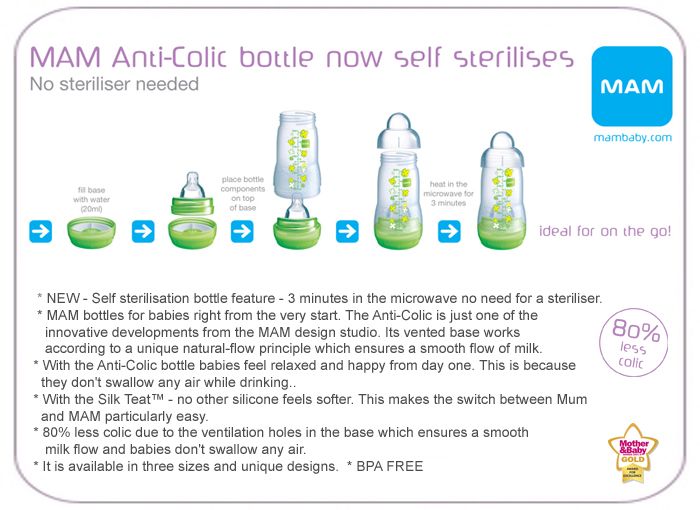 Set the timer to 90 seconds, close the door and press start to begin the sterilization process.
Set the timer to 90 seconds, close the door and press start to begin the sterilization process.
Use a clean, soft towel or tissue to remove the plastic container from the microwave. After removing the bottle from the container, dry it with a clean towel and refrigerate if you are not going to use it right away. Otherwise, pour milk or formula into a bottle and secure the nipple to the neck. nine0003
Sterilize the other bottles in the same way, with each bottle sterilized separately.
Microwave Baby Bottle Sterilization: Tips and Cautions
You can purchase a bottle sterilizer available from retail and online baby supply stores that is used in the same way as a plastic container. Dry the sterilizer with a clean towel and place the bottle inside. Pour the recommended amount of water into the sterilizer, put it in the microwave, set the time on the timer recommended by the instructions for the sterilizer and follow steps 3 and 4 of our article. nine0003
Do not close the bottles during sterilization, this will cause pressure to build up inside them and may cause an explosion.
It should be noted that in addition to a special sterilizer, there are reusable packages for sterilization in a microwave oven.
They are produced by many companies involved in the production of children's goods, for example, Medela, Philips and others. It is very easy to sterilize bottles in such packages: fold the dishes, pour water, close the package, put it in the microwave (sterilization time is indicated on the package, from 90 sec. up to several minutes).
In order not to forget how many times the bag has been used, you can mark each time on a special plate. For safe use, some manufacturers have made a spout for draining on the side.
It is very convenient to use such bags not only at home, but also to take them with you on a visit, on a trip.
If you do not have a sterilizer and bags, use regular glassware.
Pour cold water into it, put the washed bottles and microwave for 8-10 minutes at maximum. nine0003
How to sterilize baby bottles in the microwave?
- Main page
- Society
Society
October 30, 2016
Magdalena Krasilnikova
Contents
- Kaleidoscope of opinions
- Microwave Sterilization Methods
A young mother has many worries and questions related to her baby and caring for him.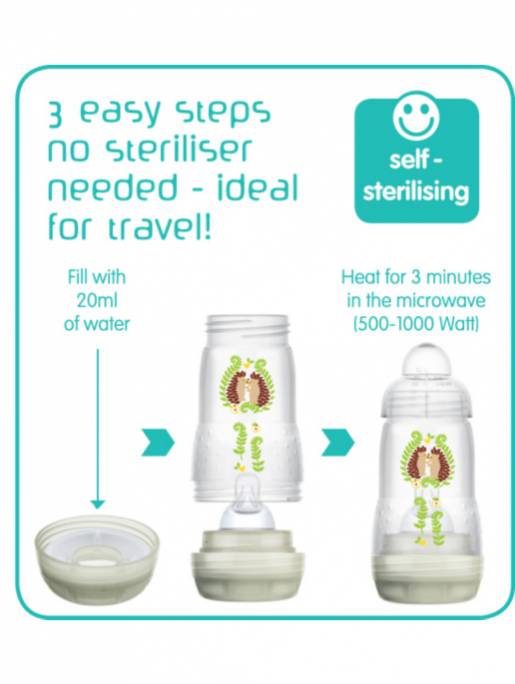 Grandmothers, girlfriends and forum talkers help find answers. One of the questions that everyone is interested in is how to sterilize baby bottles in the microwave. Each mother decides it individually, so there are a lot of ways and tips. nine0003
Grandmothers, girlfriends and forum talkers help find answers. One of the questions that everyone is interested in is how to sterilize baby bottles in the microwave. Each mother decides it individually, so there are a lot of ways and tips. nine0003
A kaleidoscope of opinions
Breastfed and bottle-fed babies have different levels of immune protection against bacteria. Our pediatricians are of the opinion that it is necessary to sterilize children's dishes and accessories in the form of nipples and toys. Foreign doctors have a radically opposite point of view. They argue that babies need to be adapted to interact with the external environment, so sterilization of feeding bottles is absolutely not necessary. Every young mother chooses the best for her child, so the choice of protection against bacteria and viruses is also within her competence. nine0003
Methods of sterilization in the microwave
As practice shows, our young mothers prefer to play it safe. For this reason, the sterilization of children's dishes in the microwave occupies a leading position.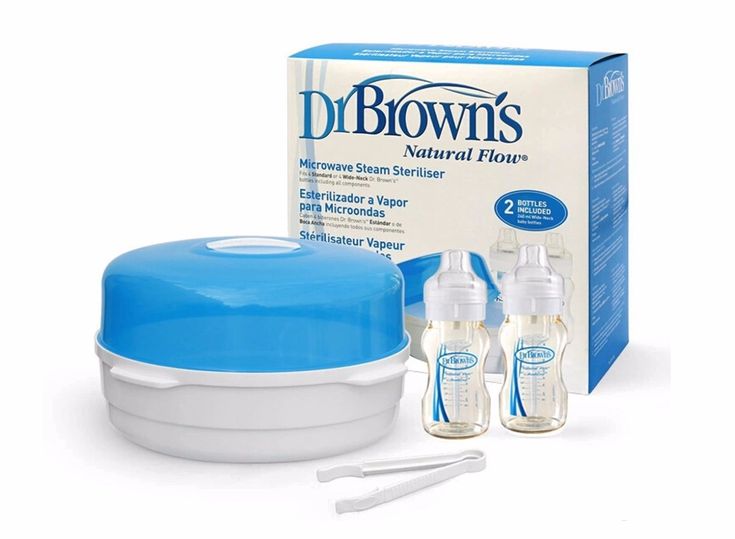 Let's start with the fact that the baby's bottles must be thoroughly washed from the remnants of drinks (juices, milk) and food (cereals, soups). To do this, you can use either standard cleaning methods with salt, soda, or you can purchase a special liquid in a baby store. Do not forget to buy special long brushes so that you can reach the very bottom of the dishes. They cost a penny, and the ease of use is obvious. nine0003
Let's start with the fact that the baby's bottles must be thoroughly washed from the remnants of drinks (juices, milk) and food (cereals, soups). To do this, you can use either standard cleaning methods with salt, soda, or you can purchase a special liquid in a baby store. Do not forget to buy special long brushes so that you can reach the very bottom of the dishes. They cost a penny, and the ease of use is obvious. nine0003
Unscrew the bottle into parts (container, cap, nipple), place them in a bowl of cold water and microwave. Sterilization takes approximately 6-8 minutes. This time is enough for the water to be brought to a boil, including the sterilization process itself. It is necessary to focus on the set microwave power mode.
A special steam sterilizer is available as an option. It is used specifically for microwave ovens. The device is simple and understandable. There is a lighter version in the form of packages. They are marked, up to which water is poured, the disassembled bottle is loaded, and then put in the microwave.

